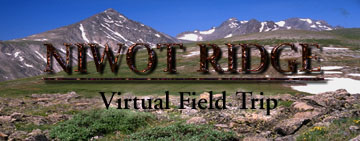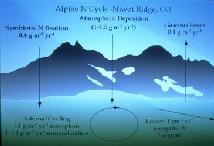
The Effects of Nitrogen on Biodiversity at Niwot Ridge
continued
 |
| Diagram of Nitrogen Cycle Click for larger image |

 |
| Diagram of Nitrogen Cycle Click for larger image |
Nearly a third of the land on Earth, and half of Colorado, is devoted to farms and agriculture. More than ever, farmers rely on commercial fertilizers to boost productivity. But if crops can't use all the fertilizer they're given, the surplus runs into the groundwater or evaporates into the atmosphere. Livestock also contribute to the escape of excess nitrogen. There's a whole lot of manure lying around Colorado, and as it dries, nitrogen in the form of ammonium (NH4) rises into the atmosphere. The large amounts of agricultural ammonium produced on farms out on the plains tend to stay near its source.
But in the area around Niwot Ridge, where Seastedt conducts his research, the overwhelming majority of nitrogen pollution comes from cars to the east, and from power plants to the west. The nitrates (NOx) from motor vehicles and smoke stacks travel long distances, entering areas uphill and upstream from their sources.
Nitrogen returns to earth in snow, wind, or rain, and its impact has been classified by researchers into a process with four stages. A stage 0 ecosystem is in balance: all nitrogen received is recycled, and none leaks into surface water. Stage 1 areas leak nitrogen into surface water during the non-growing season. Nitrogen is present in surface water all year round in a stage 2 ecosystem, and in a stage 3 area, more nitrogen flows out than in.
Seastedt points out that all high-elevation ecosystems have always been at stage 1 because their harsh environment demands that they shut down in winter, thereby allowing any nitrogen that falls to pass on to the water table. Human influence, however, has boosted Niwot Ridge's status closer to stage 2.
The difference may seem a subtle one, but geologist Mark Williams of INSTAAR notes that in the early 1980s, nitrate levels at Niwot Ridge were 30 times greater than in the pre-industrial era. Now, in the 1990s, that already elevated amount has doubled. Where will we be in another ten years? Or another hundred?
Back on the tundra, Seastedt shakes bags of nitrogen pellets onto numbered plots. During his five-year project, he will overfertilize local plants to simulate total nitrogen saturation. The project is one year old, and after just one application of fertilizer, applied last summer, the change is remarkable. Grasses burst from the meter square plots. Everything within their borders is distinctly greener than the unfertilized areas surrounding them. The effect is that of a badly sewn quilt thrown across the tundra, with Seastedt's green squares haphazardly strewn among the last of the snowpack.
Seastedt expects that at the end of the experiment, four years from now, natural selection will favor species that can tolerate high nitrogen levels. Grass will dominate the plots, and the most fragile species will have disappeared. If his image is a preview of the distant future, a fully saturated tundra would be rife with grasses and non-native weeds. Downslope, nitrogen running off into streams would cause algae to flourish, reducing the amount of oxygen available to fish. And the high nitrogen levels would encourage aluminum to move out of the soil (where it is harmless) and into the water (where it is deadly), killing fish and their food source, plankton.